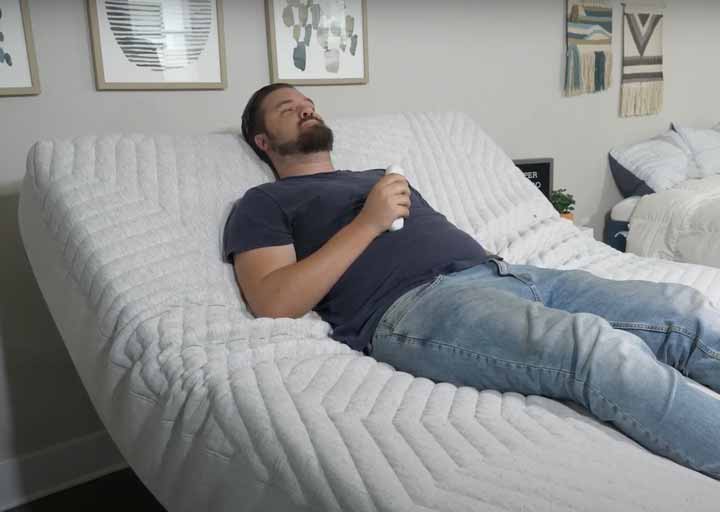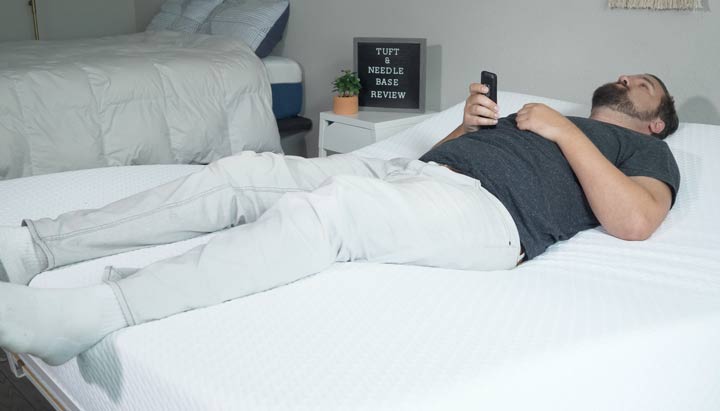Adjustable beds let you get a good night’s sleep and make the most of your bed when awake. With an adjustable bed, you can watch TV in bed or work from home in comfort. Some adjustable bed positions are also great for a variety of health concerns. Because of their lifestyle and health benefits, adjustable beds are growing in popularity.
To get the most out of your adjustable bed, the base position needs to be right for you. There are also other features to consider so your new base fits your needs. Let’s take a close look at the best adjustable bed positions!
Adjustable Bed Positions
Each of the four best adjustable bed base positions work well for different sleepers. Your individual health concerns and lifestyle will determine which position you should use.
Head Raised Position
The head raised position is perfect for sleepers who snore. Those who suffer from sleep apnea or have acid reflux should also try this position.
Snoring. If you snore, you know how much it can disrupt your sleep. If you need some relief, try raising your head to take the pressure off the airways. For the maximum benefit, raise your shoulders and head 20 to 30 degrees.
Sleep Apnea. Having your head in the upright position also helps with sleep apnea. Sleep apnea is a condition where breathing stops and starts throughout the night. Those with sleep apnea snore louder and may wake up tired even if they sleep eight hours a night. By opening the airways, this base position provides a more restful night’s sleep.
Acid Reflux. Sleeping in the head raised position supports those with acid reflux as well. Acid reflux is a stomach condition where stomach acid irritates stomach lining. The condition is often worse after eating or when lying down. By raising the head, you can ease the pain caused by acid reflux and get more rest.
Feet Raised Position
The feet raised position relieves aches and pains in the lower back and legs. Those with sciatica and leg swelling will find this position helpful.
Sciatica. Lying down can increase pressure on the joints in the back of the spine. This can be harmful for those who suffer from sciatica or other lower back pain. The feet raised position decreases that pressure for a better night’s sleep.
Leg Swelling. Whether from chronic conditions or recent injuries, lying flat irritates swollen legs. By raising your feet above your heart, gravity moves fluid from your legs to your heart to reduce swelling,
Head And Feet Raised Position
The head and feed raised position relieves pain in the muscles and joints. It also opens airways, making it easier to breathe. Those with mobility issues, asthma, or COPD should use this position.
Mobility Issues. Muscle weakness, joint pain, and nervous system difficulties usually impact older adults, but younger adults could experience them too. Underlying health issues, such as diabetes or arthritis, can cause mobility problems at any age. The head and feet raised position cradles the body, relieving aches from joint pain, restless leg syndrome, and other mobility issues.
RELATED: Best Mattresses for Seniors
Asthma. Because it can make breathing difficult at night, asthma often disrupts healthy sleep habits. COPD, a group of chronic lung conditions which worsen over time, impacts quality of sleep in a similar way. Lying down often irritates these lung conditions. Sleeping in a recliner with head and feet elevated makes breathing easier, but recliners cause muscle aches throughout the body. The head and feet raised position can help you get back into your own bed without worsening any lung conditions.
Zero Gravity Position
NASA invented the zero gravity position to reduce pressure on astronauts during takeoff. In this position, both the head and knees are raised above the heart, making the body feel weightless.
Arthritis. A zero-gravity preset eliminates stress on the joints caused by arthritis. According to the Arthritis Foundation, over 80% of people with arthritis have trouble sleeping. The zero gravity position helps soothe pain, which can improve sleep over time.
Pregnancy. Physical and hormonal changes during pregnancy can cause back pain, circulation problems, and swelling. Pregnant people can use the zero gravity position to decrease swelling and back pain as well as improve blood circulation. This position also makes back sleeping safer for the parent and baby.
Digestion. Zero gravity also improves digestion. Food passes easier through the esophagus and stomach when your head is upright. This position also limits gravity’s pull on the stomach, preventing other harmful digestive issues, such as acid reflux and heartburn.
Learn More: Best Murphy Bed Mattress
What to Consider When Buying an Adjustable Bed
Along with finding the right base position, an adjustable bed needs to fit your life. Your adjustable bed should work for your lifestyle, sleeping preferences, health, and budget.
Split Adjustable Beds Vs. Regular Adjustable Beds
A regular adjustable bed will adjust to one position for the entire bed frame. A split adjustable bed offers the option for two different sleep positions. As you might imagine, a split adjustable bed is great for couples.
Elderly couples can especially benefit from split adjustable beds. These beds can accommodate two sets of sleeping preferences and health concerns at the same time. Buying a motorized base might also make adjustments easier and quicker.
Mattress Types
While many mattresses work with adjustable bed frames, not all do. A memory foam or latex mattress will work best. Since an adjustable frame lifts and lowers the head of the bed and the foot of the bed, firmer mattresses do not work well with it. A flexible mattress handles the wear and tear of moving up and down better.
Also, make sure to check out our best mattresses for adjustable bases.
Sleeping positions
Adjustable beds work well for side and back sleepers, but not for stomach sleepers. You should avoid some adjustable base positions if you sleep on your side as well.
Side sleeping is great for those with back pain, hip pain, sleep apnea, or acid reflux. With an adjustable bed, side sleepers can get even better rest. Side sleepers should use the head and feet raised position to keep their spine in alignment.
Back sleepers can sleep in any base position. If you’re using an adjustable bed to relieve back pain, use the head and feet raised or zero gravity position.
Health
Adjustable beds ease so many health issues. Finding the right position, ultimately, boils down to what you need. Do you need the bed to aid in circulation? Improve sleep while you’re pregnant? Relieve pain from acid reflux? Make sure the base position supports your individual health.
Extra Features
Sometimes, there are extra features to make an adjustable bed more customizable. Some, such as the Lucid L300 adjustable bed, have USB ports to charge electronics. Others have bed lighting for reading at night and massage features. Extra features could make your rest time more enjoyable.
Budget
While more expensive than traditional frames, adjustable beds are more affordable Sleep Number alternatives. Within the adjustable bases on the market, there are options for different budgets. While some cost more, the expensive options may also last longer and be easier to set up. The Saatva Lineal Adjustable Base could be a good option for people on a budget who don’t want to sacrifice quality.
Pros and Cons of Buying an Adjustable Bed
While an adjustable bed creates a better night’s sleep, it isn’t the right option for everyone. When deciding whether to buy one, keep these pros and cons in mind.
Pros
- Adjustable beds improve mobility and blood flow.
- They support many health issues such as arthritis, acid reflux, and sleep apnea.
- Some adjustable beds also have extra features, such as USB ports and massage features.
Cons
- Adjustable beds can be more expensive than traditional bases.
- Your mattress may wear out quickly with an adjustable bed because it moves the top and bottom of the mattress. The Sleep Number 360 Smart Bed could be an alternative if you want your mattress to last longer.
- Some may dislike this aesthetic and prefer a traditional base in their bedroom.
FAQs
Still unsure if an adjustable bed is for you? The answers to these frequently asked questions might help you decide.
What is the best position for an adjustable bed?
The best base position differs depending on your health concerns and sleep preferences. Some argue that head and feet raised or zero gravity position is the best. Both decrease pressure on the spine and improve blood circulation.
What is the zero gravity position on an adjustable bed?
In this position, the head and knees are elevated above the heart. This creates a 120 degree angle where the lower back is the closest to the ground.
Is it good to sleep on an adjustable bed?
Adjustable beds provide a better night’s sleep for people with a variety of health concerns. They increase mobility, blood circulation, and comfort. The decrease of aches and pains which can wake you up in the middle of the night also improves sleep quality.
Do adjustable beds work for side sleepers?
A common misconception is that they are only for back sleepers. Side sleepers can enjoy adjustable bed bases as well. Just make sure both your head and feet are elevated if you sleep on your side.



